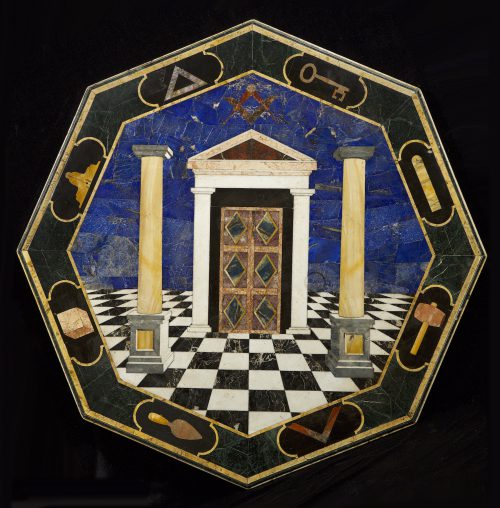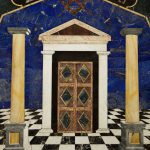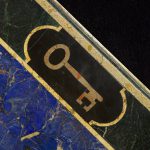9016 AN OCTAGONAL TABLETOP IN PIETRE DURE AND MARBLES DEPICTING MASONIC SYMBOLS Italian. Circa 1825. Measurements: Diameter: 47 1/2″ (120 cm) Thickness: Ca. 2″

Research
Of lapis lazuli, alabastro Egiziano, amethyst, brown onyx, and various inlaid marbles, including portoro, Siena, Spanish brocatello, and bleu turquin.
Exhibited:
Olympia International Art & Antiques Fair, London, 1995
The International Fine Art and Antique Dealers Show, New York, 1995
This extraordinary pietre dure and marble top set with rare stones depicts symbols and images significant to the secret fraternity of Freemasonry, “an Anglo-Saxon creation first transplanted to Florence in 1733… The Masonic principles of nonsectarianism and abstract belief in a “Great Architect of the Universe” were viewed as an intolerable threat by Pope Clement XII, who issued the first papal edict that ordered excommunication of any Catholics who became Masons.”1 At the time at which this piece was made, Italian Freemasons were particularly concerned with the ideals of Liberty, and played an active role in progressing the country’s struggle for unification and for freedom from both foreign and papal domination.
The octagonal shape of the tabletop is important as the octagon is derived from the “square upon square…one of the most ancient designs known” in Freemasonry.2 The architectural scene and devices of the present piece are also loaded with meaning. The significance of the various architectural elements of the temple, which forms the central motif of the present top, was explained by Bishop Guillaume Durand around 1290 when he wrote, “All the stones are polished and squared— that is holy and pure… the foundation is Faith, which is conversant with unseen things: the roof, Charity, which covereth a multitude of sins. The door, Obedience… The pavement, Humility.”3 Flanking the temple are two freestanding columns, the left-hand column a symbol of Creation, while the right hand column expresses Salvation.4 The Doric order of the columns symbolizes wisdom and strength.5 Inlaid above the Temple is a square combined with compasses, suggesting order, regularity, and propriety.6
The border to the present top is filled with the working tools of a Mason, images used by Freemasons to express the principles upon which they strive to build a better world. The level, for example, implies equality, the square symbolizes morality, while the trowel “is used for the purpose of spreading the cement of the Brotherhood and affection which unites us in a sacred bond as a Society, among whom no contention should exist.”7
Footnotes:
1. Merz, Charles H. Guild Masonry in the Making. Whitefish: Kessinger Publishing, 2006. 160.
2. “Centuries of Secrecy.” Time Magazine. 8 June 1981.
3. Durand, Guillaume, John Mason Neale, Benjamin Webb. The Symbolism of Churches and Church Ornaments: A Translation of the First Book of the Rationale Dibinorum Officiorum. Leeds: T.W. Green, 1843. 23, 25.
4. Jones, Bernard E. Freemasons’ Guide and Compendium. London: George G. Harrap, 1950. 358-9.
5. ibid., 356.
6. ibid., 435.
7. ibid., Chapter Twenty Nine.





Comments are closed.